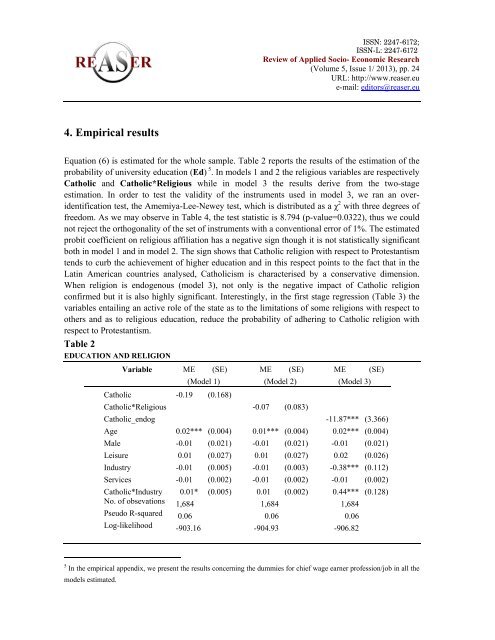new characteristics of inequalities in the information society and ...
new characteristics of inequalities in the information society and ...
new characteristics of inequalities in the information society and ...
You also want an ePaper? Increase the reach of your titles
YUMPU automatically turns print PDFs into web optimized ePapers that Google loves.
ISSN: 2247-6172;<br />
ISSN-L: 2247-6172<br />
Review <strong>of</strong> Applied Socio- Economic Research<br />
(Volume 5, Issue 1/ 2013), pp. 24<br />
URL: http://www.reaser.eu<br />
e-mail: editors@reaser.eu<br />
4. Empirical results<br />
Equation (6) is estimated for <strong>the</strong> whole sample. Table 2 reports <strong>the</strong> results <strong>of</strong> <strong>the</strong> estimation <strong>of</strong> <strong>the</strong><br />
probability <strong>of</strong> university education (Ed) 5 . In models 1 <strong>and</strong> 2 <strong>the</strong> religious variables are respectively<br />
Catholic <strong>and</strong> Catholic*Religious while <strong>in</strong> model 3 <strong>the</strong> results derive from <strong>the</strong> two-stage<br />
estimation. In order to test <strong>the</strong> validity <strong>of</strong> <strong>the</strong> <strong>in</strong>struments used <strong>in</strong> model 3, we ran an overidentification<br />
test, <strong>the</strong> Amemiya-Lee-Newey test, which is distributed as a χ 2 with three degrees <strong>of</strong><br />
freedom. As we may observe <strong>in</strong> Table 4, <strong>the</strong> test statistic is 8.794 (p-value=0.0322), thus we could<br />
not reject <strong>the</strong> orthogonality <strong>of</strong> <strong>the</strong> set <strong>of</strong> <strong>in</strong>struments with a conventional error <strong>of</strong> 1%. The estimated<br />
probit coefficient on religious affiliation has a negative sign though it is not statistically significant<br />
both <strong>in</strong> model 1 <strong>and</strong> <strong>in</strong> model 2. The sign shows that Catholic religion with respect to Protestantism<br />
tends to curb <strong>the</strong> achievement <strong>of</strong> higher education <strong>and</strong> <strong>in</strong> this respect po<strong>in</strong>ts to <strong>the</strong> fact that <strong>in</strong> <strong>the</strong><br />
Lat<strong>in</strong> American countries analysed, Catholicism is characterised by a conservative dimension.<br />
When religion is endogenous (model 3), not only is <strong>the</strong> negative impact <strong>of</strong> Catholic religion<br />
confirmed but it is also highly significant. Interest<strong>in</strong>gly, <strong>in</strong> <strong>the</strong> first stage regression (Table 3) <strong>the</strong><br />
variables entail<strong>in</strong>g an active role <strong>of</strong> <strong>the</strong> state as to <strong>the</strong> limitations <strong>of</strong> some religions with respect to<br />
o<strong>the</strong>rs <strong>and</strong> as to religious education, reduce <strong>the</strong> probability <strong>of</strong> adher<strong>in</strong>g to Catholic religion with<br />
respect to Protestantism.<br />
Table 2<br />
EDUCATION AND RELIGION<br />
Variable ME (SE) ME (SE) ME (SE)<br />
Catholic -0.19 (0.168)<br />
(Model 1) (Model 2) (Model 3)<br />
Catholic*Religious -0.07 (0.083)<br />
Catholic_endog -11.87*** (3.366)<br />
Age 0.02*** (0.004) 0.01*** (0.004) 0.02*** (0.004)<br />
Male -0.01 (0.021) -0.01 (0.021) -0.01 (0.021)<br />
Leisure 0.01 (0.027) 0.01 (0.027) 0.02 (0.026)<br />
Industry -0.01 (0.005) -0.01 (0.003) -0.38*** (0.112)<br />
Services -0.01 (0.002) -0.01 (0.002) -0.01 (0.002)<br />
Catholic*Industry 0.01* (0.005) 0.01 (0.002) 0.44*** (0.128)<br />
No. <strong>of</strong> obsevations 1,684 1,684 1,684<br />
Pseudo R-squared 0.06 0.06 0.06<br />
Log-likelihood -903.16 -904.93 -906.82<br />
5 In <strong>the</strong> empirical appendix, we present <strong>the</strong> results concern<strong>in</strong>g <strong>the</strong> dummies for chief wage earner pr<strong>of</strong>ession/job <strong>in</strong> all <strong>the</strong><br />
models estimated.








